
surfresearch.com.au
christopher middleton : digby's art of swimming, 1595.
christopher middleton : digby's art of swimming, 1595.
|
|
|
|
|
|
 |
surfresearch.com.au
christopher middleton : digby's art of swimming, 1595. |
|
Page 132
The first degree of
swimming[Breast stroke] These directions are sufficient either for his entrance which is yet to learn, or for his which is already expert in this faculty. Now that is learning to swim, as we said afore, having waded in up to waist or somewhat higher, laying himself easily along upon the water with his belly downward, and striving as much as he can to hold up his head, and draw[ing] in his arms close to his breast, holding hands broadways together under his chin with the palms down; let pull his feet from the bottom and withal put forth his hands as far as he can and draw them in again as afore, and likewise his feet. Which double motion of hands and feet serve to this use: the one thrusteth him forward and the other keepeth up his body. And because it is a toil, something to learn how to strike right thus with his hands and feet as afore, let him either get someone to accompany that may by holding his hand under his chin keep him from sinking, else take two bladders, blow them full of wind and fasten them so together that he may have them to lie under his armholes, which will easily bear him up. And thus may he do till he hath perfectly learned to swim on his belly, as the picture following showeth: (II. 2) |
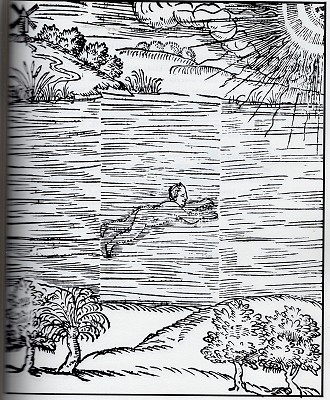 |
|
Page
164
To swim like a dog[Dog Paddle]
Into this kind of
swimming many do at the first fall, before they
perfectly learn the right stroke. And there is this difference betwixt them, that.whereas in the right kind [of stroke] he stretcheth out his hands and his feet, in this he rudely beateth the water with his hands and feet, first lifting his right hand out of the water and then his right foot, and forcibly striking them into the water again, as in this example following: (II. 14) |
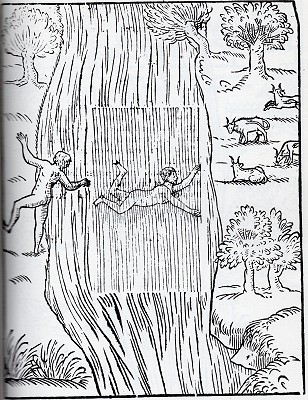 |
| Page 170 To show his toes above the water
[Floating] |
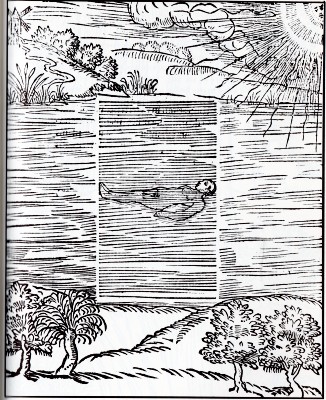 |
| Page 174
To tread the water
[Treading
water]
This is only standing bolt up as it were in the water, and pulling up your feet and thrusting them down again, after the same manner as he doth swimming upon his belly, which have the same force to keep him that way which they have to thrust him forwards the other way, as you may see in this picture next following: (II. 23) |
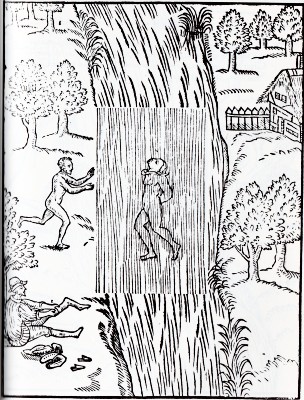 |
| Page 196 To dive
underneath the water
[Diving]
He must, if he be in a place where he may stand upon the ground, with as much force as he can, leap up, and bending his head towards his breast fall forwards down into the water, as thus: (II. 34) |
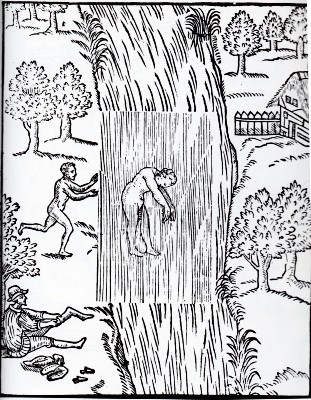 |
| Page 198 [To descend beneath the water]
[Submerging] His hands must he hold before his head with their backs together, that they may be ready to pull him as it were forcing him down under the water, and he must, pulling them out and in, now use them to help him down which were afore a means to hold him up. His feet also must strike upward, moving them after the same manner as he doth swimming above the water upon his belly, after this example: (II. 35) |
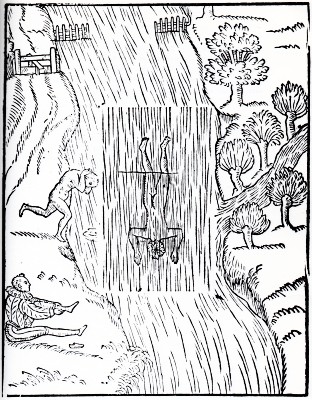 |
| Page 200 To swim under the water
[Underwater swimming]
When he hath thus buried himself in the water, he must thrust his hands forth before his head and, as it were, draw the waters which are before and beat them behind him, [and] strike with his feet as swimming upon his belly, but somewhat upward that they may the easilier keep him down, as in this example: (II. 36) |
 |
| Page 202 To rise from the bottom
[Ascending] That is done by the speedy turning upward of his body and with one hand, the palm being downwards, press down the water beneath him, and with the other hand draw down the water which is above him, and then striking downwards with his feet it will easily bring him up, as thus: (II. 37) |
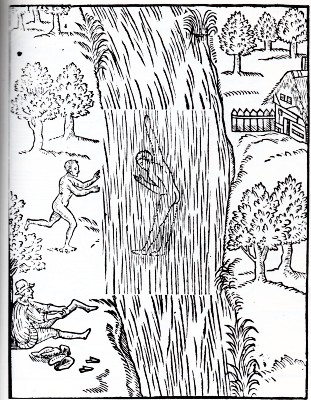 |
| Page 204 To seek any thing that is lost in the water
[Salvage, retrieval]
He must swim under the water as afore but as near the bottom as he can, so that he touch it not lest he raise any mud to thicken the water, his eyes open that he may see where it lieth. And if so be that he have any occasion to turn himself, or to seek round about as thinking himself near the thing he seeketh, if he will turn towards the left hand, he must with his right hand pull towards him the water which is on his left side, which will easily turn him about, as this picture next following showeth by example: But thus much to him which learneth to dive: let him never swim further than he can see the bottom, for it is either very deep or else he is under some bank, or in some such danger. (II. 38) |
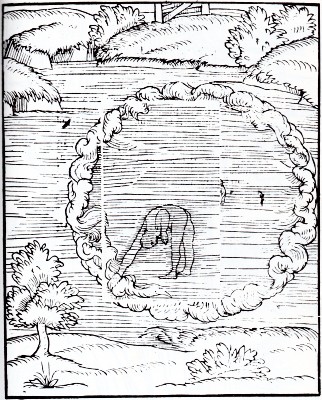 |
| Page 206 To swim like a dolphin
[Re-breathing] This is nothing else but in diving to lift his head above the water, and when he hath breathed, presently dive down again, as afore: (II. 39)
FINIS
|
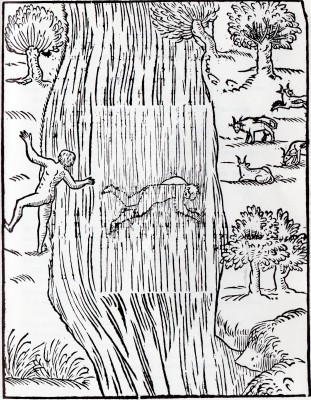 |
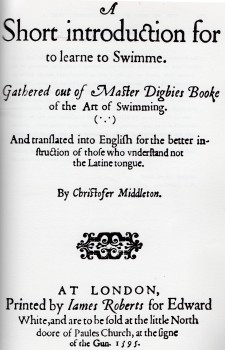 |
Middleton, Christopher: A Short Introduction for to Learn to Swim, translated from Digby's De Art Natandi, 1587. Edward White, London, 1595. Reproduced in: Orme, Nicholas: Early British Swimming 55 BC - AD 1719 University of Exeter, 1983. |
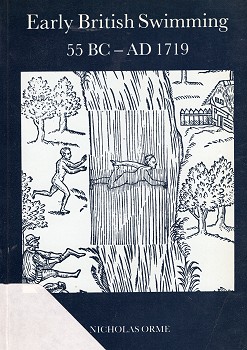 |
|
|
|
|
|
|